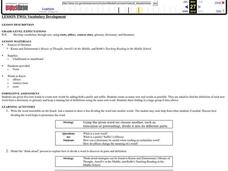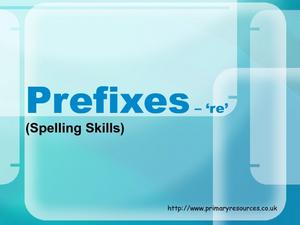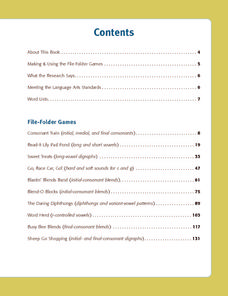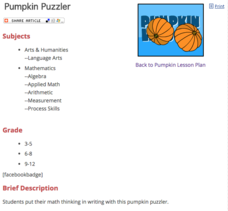Curated OER
Making Sense of Homographs
What is a homograph? Develop your students' vocabulary with a word association tool. Language arts classes discover what a homograph is and how it can be used as a visual thesaurus. They discover the other uses for homographs such as...
Curated OER
What is a Haiku? How Do You Write a Haiku?
Haiku poetry is explored in this language arts lesson. Yong readers identify the characteristics of haiku and read several examples. Students make connections between their study of Japan and the poetic form of haiku, and they write...
Curated OER
At the Crayon Factory: high frequency and spelling words
After reading the story At The Crayon Factory learners complete 4 different language arts activities. They write spelling and high frequency words, fill in the blanks to sentences, answer short answer questions, and write sentences.
Curated OER
Vocabulary Development
What is a root word? What is a prefix? Suffix? Use these questions to spark a discussion amongst your language art learners. Then, start by writing the word irresistible on the board and have teams of learners attempt to create new words...
Curated OER
Counting Sentences' Words
Explore language arts by completing a worksheet with class. They read the story Owl Moon and discuss the rhythm of the writing and how action verbs are used appropriately. Then complete a writing worksheet which discusses writing...
Curated OER
House Hunting Guided Reading
Young scholars participate in a discussion about the book House Hunting, review vocabulary words and are instructed to group words to read smoothly. In this language arts lesson plan, young scholars complete comprehension questions and...
Curated OER
Compound Word
Learners explore compound words. In this language arts lesson, young readers complete a compound word matching activity. They divide compound words and create compound words.
Curated OER
Sentences and Non-Sentences
Use the popular theme of sharks to discuss complete sentences and sentence fragments with your language arts class. This is a great, interactive exercise to get all of your learners involved. Consider pairing kids up in teams to create...
Curated OER
Classifying Information About a Main Idea
Elementary learners explore language arts by completing a text identification activity. They discuss the importance of a main idea in a story or paper and how to present it properly. Then they practice identifying the main idea in sample...
Curated OER
I Can Write a Poem
Using an outline, learners write a poem. The poem is focused on highlighting their experiences. This is a great way to combine language arts and an exploration of self esteem.
Curated OER
Writing a Story - How do I Start?
Terrific tips on how to start a story is the focus of this language arts presentation. Tips include: describing what's about to happen in the story, examples of sentence openers, and how to capture a reader's attention right away. There...
Curated OER
Prefixes -"re"
The prefix, re- is the star of this basic language arts presentation. Learners are introduced to the prefix by reading a variety of words that use it. They discover that it means to do something again. As the PowerPoint goes on, learners...
PBS
Blue Ribbon Readers: Drawing Inferences
Model for young readers how to use illustrations, chapter titles, and events in a story to draw inferences and make predictions. Learners then practice these essential comprehension strategies by drawing inferences for another section of...
Curated OER
Language, As Experienced Through Pin-Hole Photography
Students read about and discuss photographic principles and, under the direction of the art teacher, construct individual cameras from heavy black cardboard and thin sheet metal with a hole for the lens and black tape for the shutter.
Curated OER
Writing about Art:Comparing Portraits
Young scholars compare and contrast an academic and Impressionist portrait. In this art history lesson, students look at two different styles of painting and write a paragraph as if they are the subject in the painting. They compare and...
Hawaiʻi State Department of Education
Picture Poetry
What a fun idea! The class discusses, and then writes free-verse poems using sensory detail. They get into small collaborative writing teams to compose their poems. Next, they pantomime the actions from the poem while their teammates...
Curated OER
Using Games to Reinforce Vocabulary Development in English Language Learners
Practical ways to implement games and activities into whole-class and sheltered English language development time.
Mari
Word Herd
Practice r-controlled vowels with a phonics game and worksheet. After rolling the dice, kids land on spaces on the game board and then find the matching r-controlled word in their stack of cards.
Virginia Repertory Theatre
The Town Mouse and the Country Mouse
Accompany the story, Town Mouse Country Mouse by Jan Brett with an assortment of activities designed to reinforce concepts covering story structure, comprehension, grammar, and social studies. Here, scholars identify the difference...
Roald Dahl
The Twits - Dirty Beards
The problem with beards is that they collect a lot of food. The first lesson plan in an 11-part unit related to The Twits by Roald Dahl explores the hairy jungle that is Mr. Twit's beard. A concluding project has learners create their...
Hawaiʻi State Department of Education
Changing Scapes
Culture and art are two things that change with time and context. Learners compare and contrast two landscape prints from different time periods. They work through art terminology to help them describe what they see in each piece. The...
Achieve3000
Discriminating Phonemes 2
Some sounds sound very similar! Help your class learn how to distinguish between various sounds by following the steps outlined in this plan. The plan includes a warm-up, a teacher-led portion, and details for guided and independent...
Museum of Disability
A Picture Book of Helen Keller
Teach your class about Helen Keller and her accomplishments with a reading comprehension lesson based on A Picture Book of Helen Keller by David A. Adler. As individuals read, they answer discussion questions about Helen Keller and the...
Education World
Pumpkin Puzzler
Light the Halloween festivities with an exercise that connects math, physical science, and language arts. After watching a demonstration of a burning candle, learners use division, multiplication, or algebra to determine how many boxes...
Other popular searches
- 5th Grade Language Arts
- 3rd Grade Language Arts
- 4th Grade Language Arts
- Second Grade Language Arts
- English Language Arts
- 1st Grade Language Arts
- Kindergarten Language Arts
- Language Arts Jeopardy Game
- First Grade Language Arts
- Language Arts School Projects
- Language Arts Lesson Plans
- Language Arts Games

























